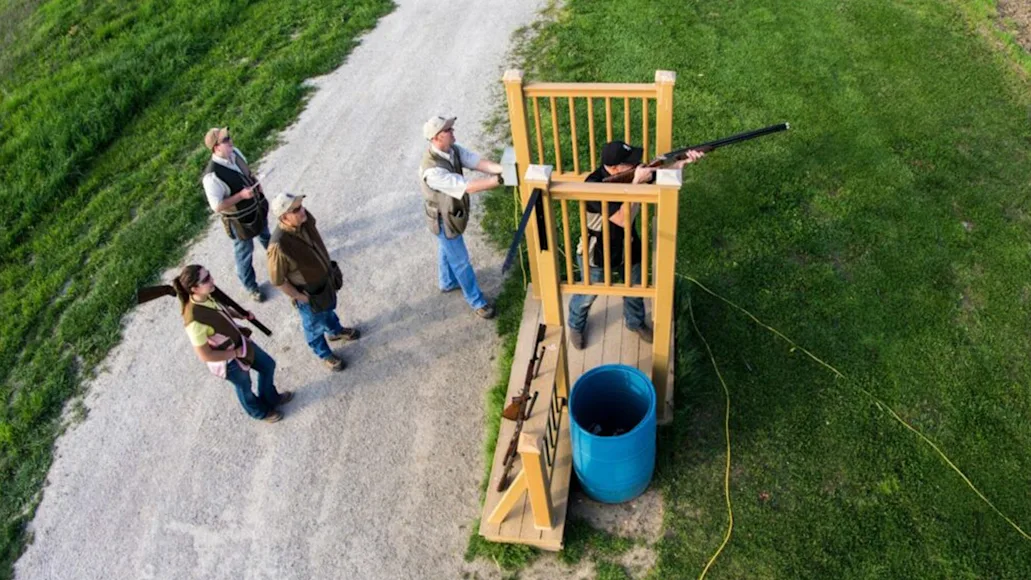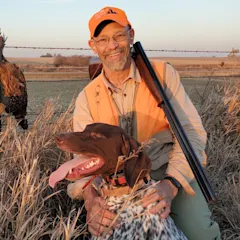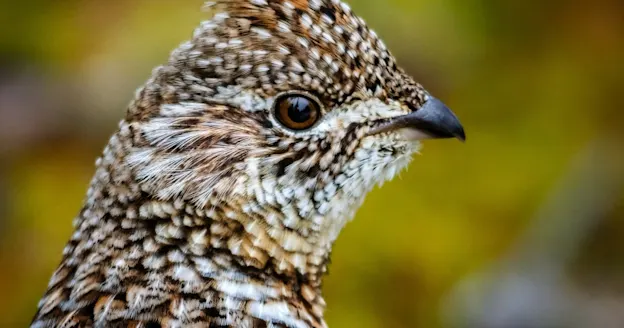We may earn revenue from the products available on this page and participate in affiliate programs. Learn more ›
_
Clay birds make the best reactive targets of all. They come at you, fly away, cross, drop, bounce on the ground, and you never tire of seeing all the different ways they break: into big pieces, little pieces, or hanging puffs of dust.
Trap, skeet, and sporting clays are the three most popular target games in the United States. All three help you become a better field shot, and all three can become addictive in their own right, making you look forward to shooting season as much as you look forward to hunting season.
Starting out can be intimidating. Everyone else at the gun club seems to know each other and to know what they’re doing. The first time I shot skeet I was squadded with a state champion, who casually smoked a cigarette while smoking all 25 targets as I flailed to break barely half. But, like almost everyone I’ve met at gun clubs, he was friendly to a beginner, and the game was fun. I kept coming back.
You’ll fit in as long as you’re safe and understand basic etiquette. In fact, most shooters are welcoming and ready to give you all kinds of advice. About half of it will be worth listening to. The trick is figuring out which half. To help you with that part, here is some basic advice on starting out in the clay target games.
Trap, Skeet, and Sporting Clays: Table of Contents
The Basic Gear for Trap, Skeet, and Sporting Clays
Trap
Trap Technique
Trap Etiquette and Safety
Trap Guns and Loads
Skeet
Skeet Etiquette and Safety
Skeet Guns and Loads
Sporting Clays
Sporting Clays Etiquette and Safety
Sporting Clays Guns and Loads
Guns to Consider
The Basic Gear for Trap, Skeet, and Sporting Clays
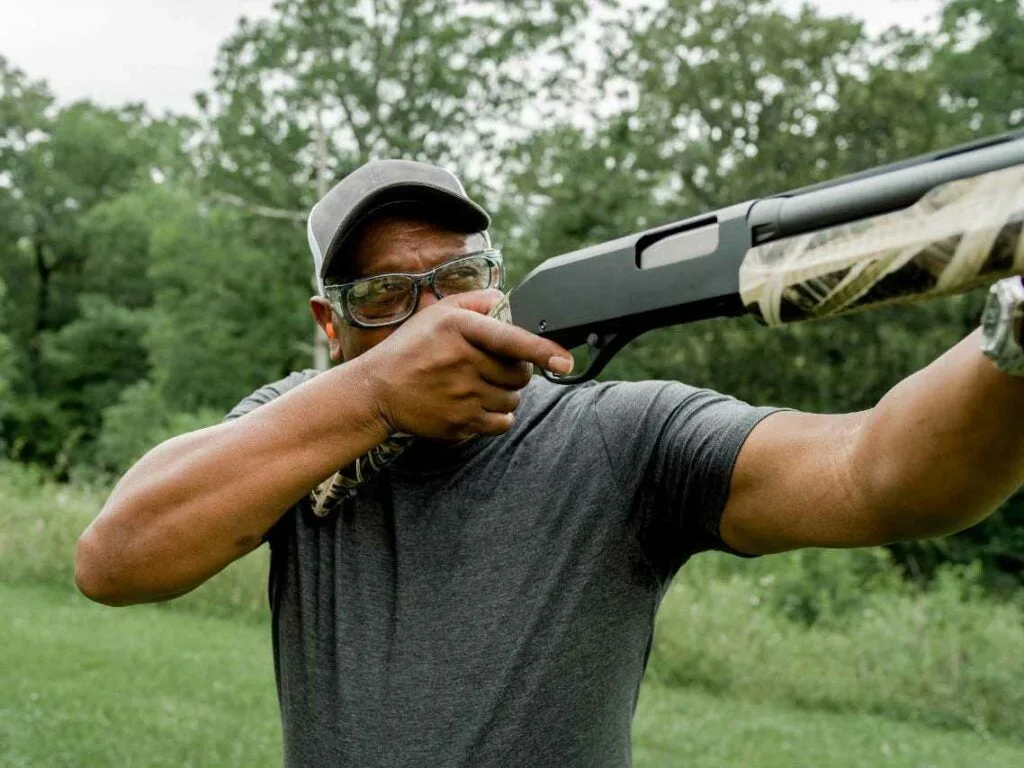
Ear protection and eye protection are required for shooting on clays courses. NSSF
In addition to a gun (there will be lots more on that part to come), you will need ear protection, eye protection, and a means of carrying your shells.
Ear Protection
Most clubs require eyes and ears. Simple foam earplugs, properly worn, do an excellent job of protecting your hearing. Some people find molded earplugs more comfortable. Personally, I wear foam earplugs under electronic ear muffs because I am fanatical about protecting my hearing.
Eye Protection
Even inexpensive (like $15) shooting glasses are tough enough to turn pellets fired from 10 steps. Choose a tint like vermillion that makes orange targets pop out against any background.
The standard advice on lens colors is to use the lightest tint possible. Dark lenses make you work harder to see targets. Trap and skeet fields almost always face north, so you never need dark lenses for those games. Sporting clays stations face all directions, and you might want a couple of pairs of glasses or one pair with interchangeable lenses. Prescription glasses and prescription inserts exist, so you can use the same corrective lenses with several interchangeable colors.
Shooting Vest and Bag
When you’re starting out, you’ll need a vest—either a shooting vest or your upland vest—or a shell pouch that holds a box of shells plus a couple of extras and your empties. For sporting clays, you’ll also want a bag that carries four or five boxes of shells and maybe a bottle of water.
Trap
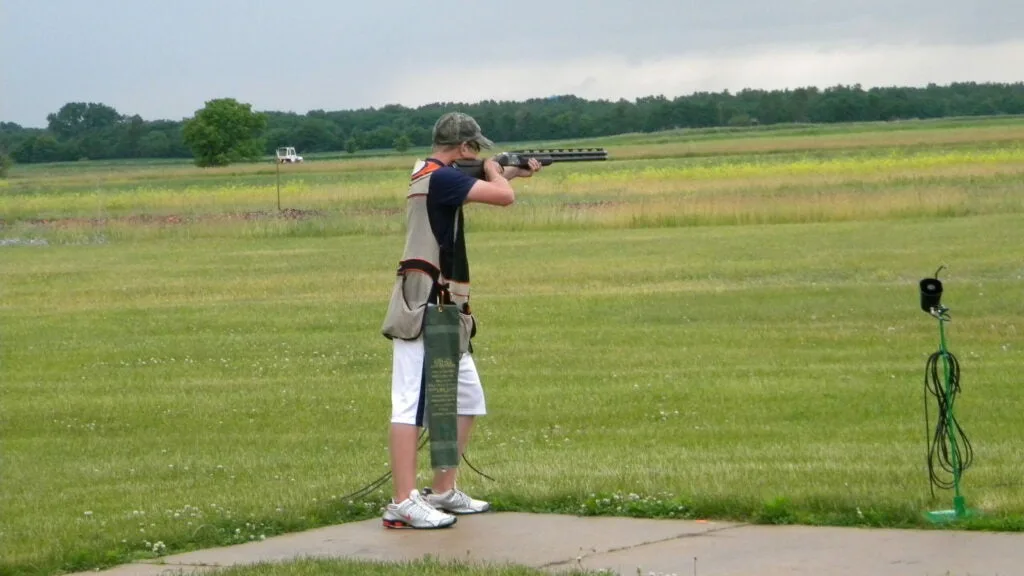
| Trap is the most popular clay target game in the U.S. Phil Bourjaily |
Originally invented as a bloodless substitute for live pigeon shooting, American trap—as opposed to international or bunker trap shot by the rest of the world—is our most popular target game. The going-away shots trap presents are very much like those you see while upland hunting, and it’s good training for pheasant and quail hunters.
American trap consists of three disciplines: 16-yard singles, doubles, and handicap. In all three, shooters rotate among five posts set in a semicircle starting 16 yards from the trap, which oscillates, throwing birds at consistent heights but random angles. You shoot five shots at each post (five pairs in doubles) for a total of 25 shots, taking turns with the rest of the squad.
Trap Technique
Trap starts with a pre-mounted gun. When you call for the target, the trap will throw it left, right, or straightaway. Consistency is crucial to good trap scores, and consistent shooting starts with a pre-shot routine. Mount the gun to the same hold point for each post. Most people like to point their gun on or a foot above the back corner of the house from post one, on or a foot above the halfway point between the back corner and middle on two, on or above the middle on three, and so on.
If you look at your bead or at the trap, the target will seem to streak away from you, and you’ll have to chase it. Instead, lift your eyes off the bead and look over the trap into the distance. Give yourself a second to let your eyes settle (this is really a thing). Think a positive thought. See the target break in your mind, then call pull.
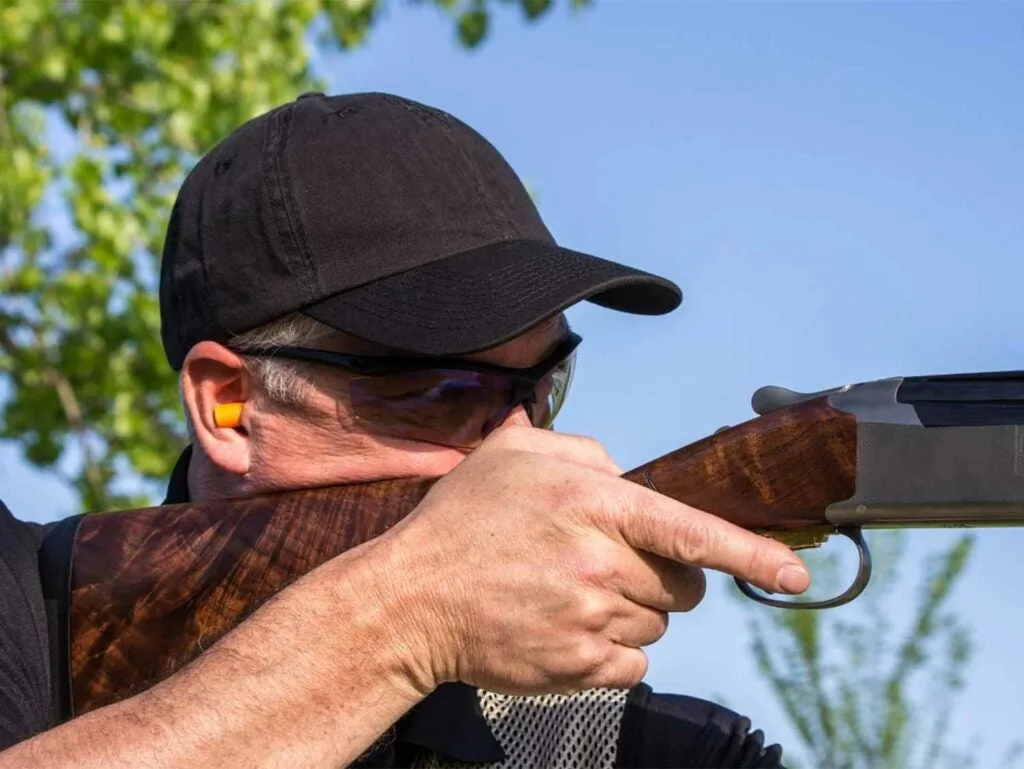
| When shooting trap, you start with a pre-mounted gun. NSSF |
Despite what people may tell you, you cannot “read” a trap or guess the angle. See the target emerge, read its angle, then move the gun through it and shoot. One instructor tells students to imagine the target as a balloon tied to the house. You run your gun along the string to the target and shoot.
Move the gun just fast enough to catch and pass the target. Keep your head on the stock, your eye on the target, and the gun to your shoulder until after the bird breaks.
Trap Etiquette and Safety
Keep your gun’s action open when waiting to shoot or moving from post to post. Load one shell at a time. You can have a live shell in your gun’s action as you wait your turn, then close the gun when it’s time for you to shoot. Control your empties. It’s easy enough to hold your hand over the breech of a break-action or the ejection port of a pump, but you’ll need a clip-on shell catcher (T&S makes them for a variety of semiautos, and Birchwood-Casey has a universal model) or even a rubber band around the receiver to keep shells in the gun and prevent them from bouncing off the person to your right.
There’s no talking in trap. Socializing is okay before and after the round, but not while you’re shooting. You’re likely to be grouped with unknown shooters, and trapshooters hate it when a squad’s rhythm is disrupted. Don’t rush, but don’t slow the squad down.
Trap Guns and Loads
Any gun that shoots once works for singles and handicap. Typically, trap guns are 12 gauge, long-barreled, tight-choked to break targets at 35 yards and more, and heavy, both to point smoothly and soak up recoil. Often, they’re set to shoot somewhat high, allowing you to “float” the rising bird over your gun barrel. If you’re interested in trap for hunting practice, put a Modified, IM, or Full choke in your gun and shoot.
In trap, as in all shotgun sports, no shot larger than 7½ lead or steel 6 is allowed (some clubs don’t allow steel due to the increased danger of ricochet). An ounce or 1⅛-load of 7½ or 8 shot works well, and a 1-ounce load at 1180 fps. will break all the targets you want without undue recoil. There is no need to shoot heavy, 3-dram, 1⅛-ounce handicap loads until you move back from the 16-yard line in handicap trap.
Skeet
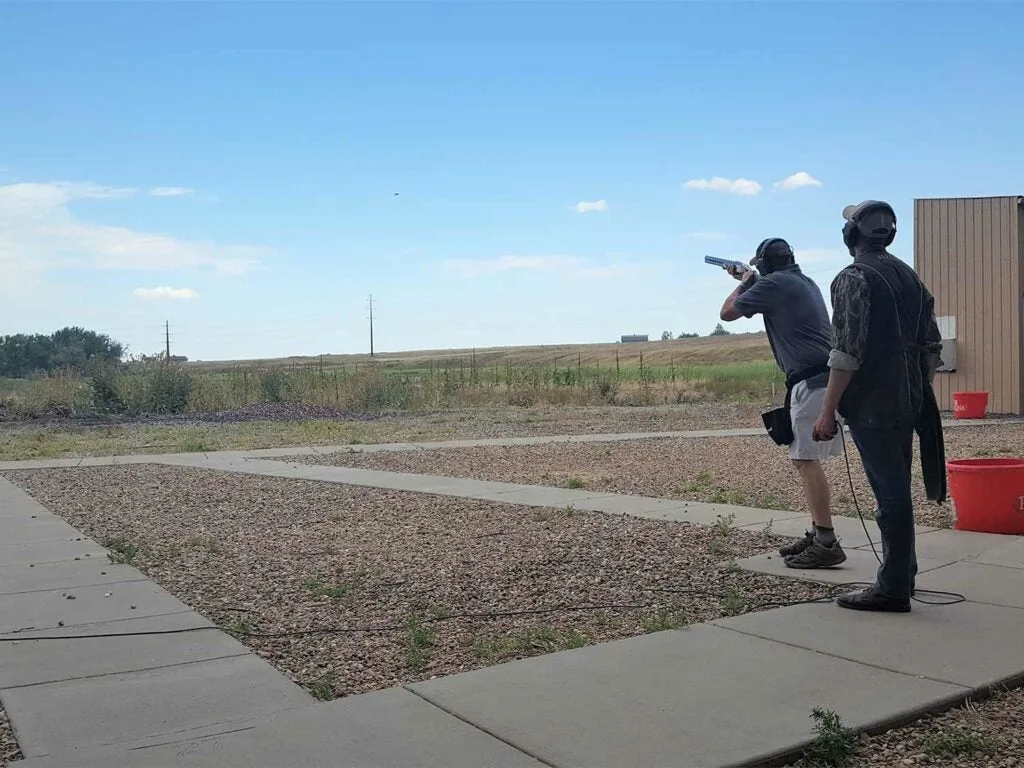
| Skeet shooting takes place around a half-circle of seven shooting stations. NSSF |
A couple of New Englanders invented Skeet around 1920 as a way to practice grouse hunting. I think it’s a much better simulation of the shots you get in the dove field and the duck blind than it is of upland hunting. Regardless, the skeet field is a great place to learn to lead flying targets, and, in fact, skeet was taught to aerial gunners during WWII for that exact reason.
A skeet field consists of two trap houses, one tall and one short (high and low houses), with seven shooting stations arranged around a half circle connecting the two. The last station, Eight, lies halfway between the houses. You shoot a high and low house single at all stations and doubles at 1, 2, 6, and 7. You repeat your first miss (it’s called the “option,” but it’s not optional), and if you don’t miss, you shoot the last target, low eight, twice to make a round of 25 shots.
Skeet Technique
If you’re a right-handed shooter, you should point your belly button at the low house from stations 2 through 6. Most people shoot skeet with a pre-mounted gun, although those of us who shoot it for hunting practice often prefer a low gun start.
As in trap, where you start the gun and where you look for the target are very important. You can find charts of hold points and look points online, but a good rule of thumb is to start your gun somewhere between a third and half the distance from the house to the center of the field, although it will vary from station to station. Your eyes should be closer to the house than your gun is. Your hold point should also be below the line of flight so you have a clear view of the target unobstructed by your gun as you swing. Ideal hold points and look points vary for everyone. You’ll want to experiment to see what works for you.
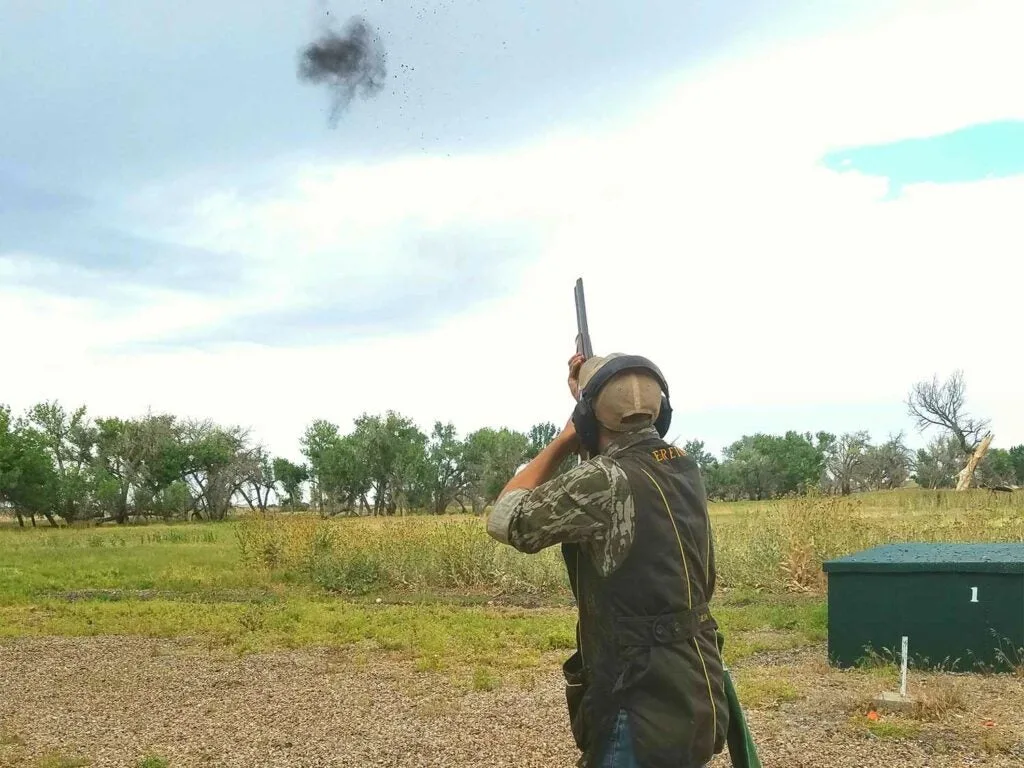
| Focus on the target, not the bead of your shotgun, if you want to break clays. Phil Bourjaily |
There are two ways to shoot skeet birds. You can either swing through them, starting the gun behind and moving it past the bird, or keep the muzzle ahead of the bird throughout the shot. That style, known as “maintained lead,” is popular among competitive shooters.
In either case, your eye belongs on the bird, not the bead. Focus on the front edge of the clay and let the gun become a blur in your peripheral vision. If you shoot maintained lead, move in time with the target, or just fast enough to pass it if you shoot a swing-through method.
Skeet doubles present a shot you never see in the field: two birds flying right at one another. On doubles, you shoot the outgoing target first. Don’t rush so fast to get to the second shot that you miss the first. See that outgoing target break, then bring the gun back to almost 90 degrees and find the second bird, which will be only a few yards away.
Skeet Etiquette and Safety
Most shooters load two shells at a time for the high and low singles, then another two for the double. The exception is station eight, where you only load one at a time. Keep your action open, and wait until you’re standing on the station to load your gun. Police your empties if you’re shooting a pump or semiauto, either at each station or at the end of the round, depending on what your squadmates prefer. Rounds of skeet can be quite sociable. Talking is allowed on a skeet field so long as you’re not distracting the shooter.
Skeet Guns and Loads
Tournament Skeet is shot in 12, 20, 28, and .410. Any one of those gauges, or a 16 if you’ve got one, can break all the targets on the skeet field, although the .410 frustrates even experts. While you rarely see pumps in competition today, they once dominated the game, and there’s no reason not to hone your shucking skills on the skeet field if you want to.
Although Skeet is a great game for keeping sharp with your field gun, competitive shooters prefer longer, heavier guns with 28- and 30-inch barrels, and most shoot O/U guns that can be fitted with sub-gauge tubes that slide into the barrels, allowing them to shoot all four gauges with one gun. Those of us who like shooting good scores but don’t plan to compete often shoot skeet with a sporting clays gun. Skeet guns have Skeet chokes, with “Skeet” being almost no constriction, insuring broad patterns at the close ranges where skeet targets are broken. If you don’t have a skeet choke, Improved Cylinder is almost as good.
Serious competitors use 9 shot, but 8s work fine for informal skeet. Loads needn’t be heavy as even the ¾ ounce 28 gauge load is more than enough to crush targets. Choose a mild load of 8 or 9 shot in whichever gauge you prefer.
Sporting Clays
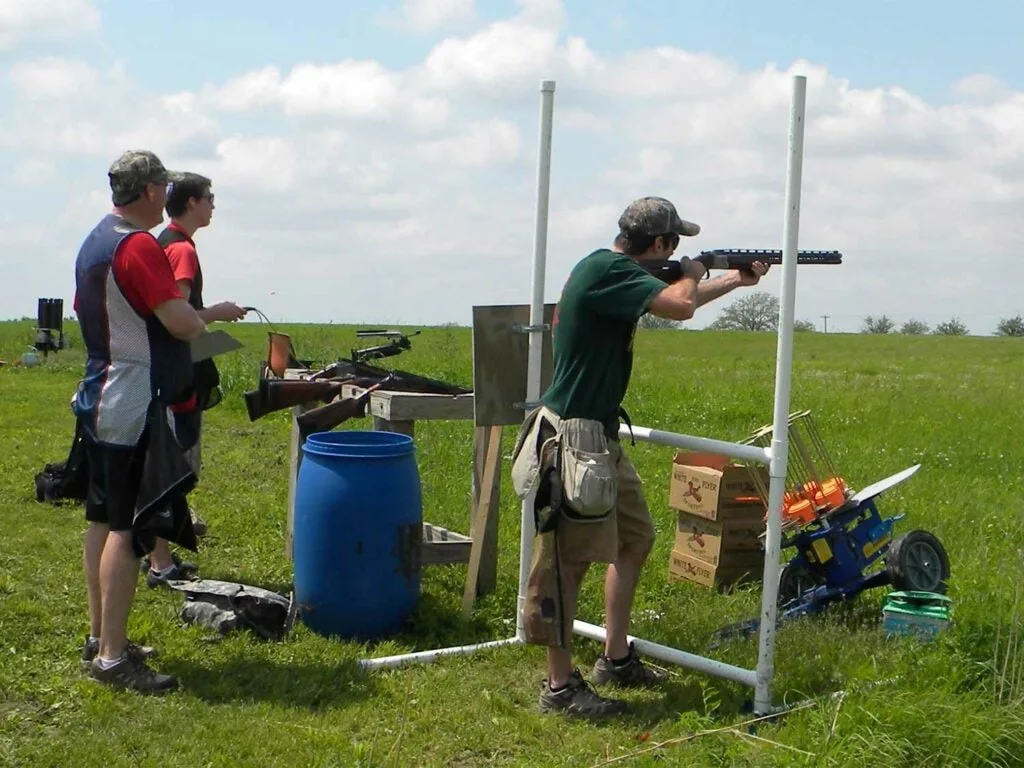
| Every sporting clays course is comprised of several stations, each with their own unique presentation. Phil Bourjaily |
Originally called “Hunter’s Clays,” Sporting Clays came to the U.S. from England, and, per its name, was intended as a practice game, with shots simulating typical field shots. Sporting Clays is laid out on a walking course, with ten or fifteen stations each offering a different presentation. In those early days, you might shoot from a boat at targets thrown over a pond to simulate decoying ducks, or you might have to pass up a differently-colored “poison” bird representing a hen pheasant.
That was then. As it became popular, and shooters got better and many people who had no interest in hunting picked up the game, it changed. You’ll see targets now that you’d never see in the field, looping, falling, bouncing, streaking straight up, and more along with plenty of crossing, incoming, and outgoing birds you would encounter in the field. But, it’s all great fun, and sporting clays is still the best practice game for hunting.
In addition, unlike trap and skeet fields, no two sporting clays courses are the same, and club managers change them up regularly. It’s always new and different. Not only is that variety a blessing for those of us with short attention spans, but it also means that, unlike trap and skeet where everybody is grooved in and perfect scores are common, hardly anyone breaks them all in sporting clays.
While a round of trap or skeet takes about 15 minutes, shooting the usual round of 100 sporting targets takes over an hour. Some clubs do rent carts and most serious competitors trailer their own decked out ATV clays cars to shoots.
A round usually consists of five pairs of targets shot at each of ten stations. Pairs are thrown three ways: true (both in the air at once), following (one, then another), and report, where you shoot one, then, on the report of your gun, the second target is thrown.
You get five identical pairs at each station, and the first shooter gets to see a show pair before they start shooting.
Sporting Clays Techniques and Tips
Good sporting clays shooting begins before you ever step into the cage. Watch the show pair. Think about where you want to shoot each bird, or which one you’ll shoot first if it’s a true pair. Have an idea where you will start your gun, and where you’ll pick up each bird with your eyes. Then, follow the show targets all the way to the ground. Often, target setters will trick you into thinking a target is farther away or closer than it is. Seeing a target hit the ground lets you judge distance more accurately.
Armed with your plan, step up and shoot. As in all clay sports, routine is important. Rehearse the shot in your mind first. Think about where you will look for each target, where you will start your gun before each pair. As long as the birds are breaking, stick with your plan. If it’s not working, change something. Shoot the target sooner, or later, lead it more, lead it less, whatever, just don’t do the same thing five pairs in a row if you’re missing. Keep a steady tempo as you shoot. It’s easy to rush through five pairs, which almost always leads to missing.
The variety among sporting clays targets means learning different methods. Some targets are easy to swing through like trap targets, while longer targets are usually easiest with a maintained lead method.
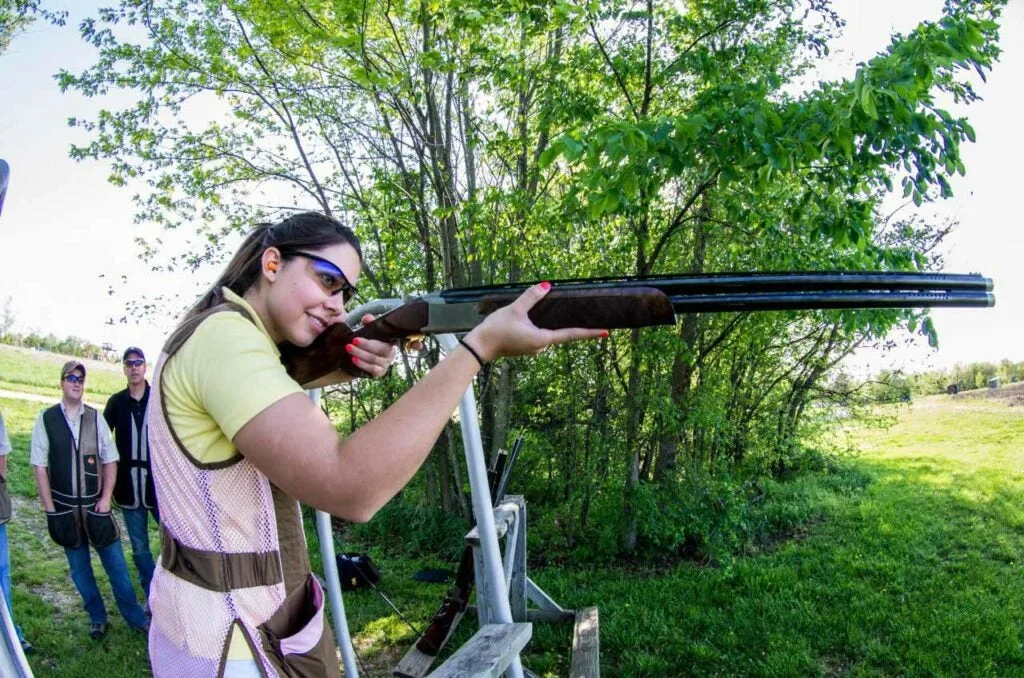
| Sporting clays also allows a pre-mounted gun like shown here. If you’re a beginner, this is a helpful technique to use. NSSF |
Sporting clays allows a pre-mounted gun, although back when I learned the game you had to shoot from a low gun start. Some shooters use a hybrid style, putting the gun to their shoulder but keeping their head up to better see the target, then moving the stock up into their face to make the shot. I’ll shoot low gun for some targets, as I think it gives me a better view and lets me make a better move, but I’ll pre-mount the gun for going away birds.
If this all sounds like a lot to absorb, it is, but it’s also part of the fun of the game. You’ll never master it, and you’ll never stop learning. The best thing to do is to plunge in. I’ve shot with plenty of hunters trying their first round of sporting clays. No matter how many targets they hit and missed, all of them had fun, and almost all of them came back for more.
Sporting Clays Safety and Etiquette
You shoot from a cage at each station, although that cage can be anything from an elaborate raised wood platform to some PVC pipe to a hula-hoop on the ground. Wait until you’re standing in the cage to load two shells. Your muzzle goes over the waist-high barrier and downrange when you load, not inside the cage. When you’re not shooting, your gun is either pointed down at the ground with the action open, or it’s in a rack. Point your finger, not your gun, at show targets if you’re not in the cage.
Sporting clays is the most sociable target game of all. You’ll often be squadded with strangers, but you’re usually friends by the end of the round. Cheering, razzing, and advice are all allowed within reason, and most experienced shooters are happy to see newcomers trying the sport and are free with advice if you ask them.
Sporting Clays Guns and Loads
You can shoot any gun at sporting clays so long as if fires twice reliably. O/Us and semiautos dominate the game. Most are 12-gauges, although there are shoots for small-gauge guns, and a 20-gauge can handle most targets. Sporting O/Us have 30- or 32-inch barrels while semiauto barrels are usually 28 or 30 inches. The variety of targets makes the two chokes of an O/U an advantage, and some shooters will change chokes at each station to match the target presentations, while others choose a versatile combination and leave it in. Light Modified in one barrel and Improved Modified in the other make a popular combination, and many semiauto shooters use Light Modified only. A field gun choked Improved Cylinder/Modified or a semiauto with an IC choke will see you through most courses just fine.
An ounce to 1⅛ ounces of shot in 7½ or 8 shot handles most sporting targets. A standard ⅞-ounce 20 gauge load will break all but the longest birds. Sporting clays rules allow faster loads than do American trap and skeet, but the 1300 fps. and faster loads you’ll see offered as sporting clays ammo kick hard and don’t offer much advantage except on extremely long shots.
The Best Shotguns for Clay Target Shooting
You can, and absolutely should, take whatever gun you already own to the club and dive into the clay target games. Once you figure which game(s) are for you, you can think about a target gun. Gear isn’t everything, but a gun made for target shooting will improve your scores and make clay shooting easier and more fun. Buy a good gun that will hold up, as a target gun has to endure hundreds or even thousands of rounds a year.
The biggest mistake I see people make in buying their first target gun is picking one that’s too light. It feels good in the store, and you figure it will be fast to the target, but light guns don’t point as well or swing as smoothly as heavier guns, and they kick much harder, too. Also, hardly anyone ever wishes they had bought a gun with a shorter barrel so don’t be afraid of a longer, heavier gun.
Gun fit matters in target shooting, too. A gun that fits not only hits where you look, but it’s more comfortable to shoot, too. When you mount the gun, your eye should align with the rib easily. If you have to contort yourself to put your head in the right spot, either find a different gun or consult with a gunsmith.
If you’re looking for an all-around target gun, remember that it’s possible to shoot trap, skeet, and sporting clays all with the same gun, but it’s much easier to shoot decent trap scores with a skeet or sporting gun than it is to shoot good sporting and skeet scores with a trap gun.
Unless you’re competing at the highest levels of skeet where you might want a dedicated gun, a sporting clays gun is easier to find than a skeet gun, and it works just as well.
Guns to Consider
1. Browning BT-99

| The Browning BT-99. Browning |
If all you want to do is shoot singles and handicap trap, the classic single-shot, break-action BT-99 is the gun you want. It’s simple, reliable, shootable, lasts forever, and, starting at $1500, a lot of gun for the money. A version with a fully-adjustable stock costs $1879 and would be a good choice if you’re hard to fit. It comes in both full-size and micro versions for smaller shooters. browning.com
2. Winchester SXP Trap

| The Winchester SXP Trap. Winchester |
The Turkish-made SXP pump makes up into a nice entry-level dedicated trap gun that gets you into the sport for very little money. It features a trap-style stock, good recoil pad, high rib, and a smooth pumping stroke if you decide to add doubles to your repertoire. The triggers on these can be heavy, but for $479 what do you expect? There are compact and full-size versions available. winchesterguns.com
3. Tristar Viper G2 Sporting

| The Tristar Viper G2 Sporting. Tristar |
Turkish-made semiautos keep getting better, and Tri-Stars have won a loyal following among their owners. The G2 is a gas gun, so it offers some recoil relief, and it comes both in a synthetic version and a pricier adjustable walnut model. They start at $665. tristararms.com
4. Beretta A300 Outlander Sporting

| The Beretta A300 Outlander Sporting. Beretta |
Utterly reliable and soft-shooting, Berettas have long been the favorite among serious sporting clays competitors who prefer a semiauto. The A300 is more or less the old 391 (Beretta’s previous flagship semiauto) and is made in U.S. as a price-point gun. It has a 30-inch barrel, extended chokes, target style stock, and wider rib, along with all the dependability you expect from Beretta. It would be my pick for an entry-level semiauto. $1100; beretta.com
5. Browning Citori CX

| The Browning Citori CX. Browning |
Intended as a gun that can crossover from field to target range, the 12-gauge CX comes in 28-, 30-, and 32-inch barrels and it has a slightly high point of impact that makes it a good all-around gun for trap, skeet, and sporting clays. The Citori is a proven, rugged design that will hold up through a lifetime of shooting. There is also a CXS version which is slimmer, a little lighter, and geared specifically toward skeet and sporting clays. $2199; browning.com
6. CZ Redhead Premier Target

| The CZ Redhead Premier Target. CZ USA |
Turkish-made CZ guns have earned a reputation as durable, affordable guns made by a company that stands behind them. The Premier Target comes in 12 or 20 gauge, would make a good all-around clay-breaker, and leave you enough change in your pocket to pay for your rounds. $1430; cz-usa.com
7. Beretta 686 Silver Pigeon Sporting I

| The Beretta 686 Silver Pigeon Sporting I. Beretta |
A trim, bullet-proof action makes the Silver Pigeon Sporting a natural pointer and a gun you’ll have to work hard to wear out. I once saw a World Champion’s 687 (same gun, but fancier decoration) with 500,000 rounds through it. Parts of the stock were held together with electrician’s tape, and it was still smashing targets. $2350; beretta.com
8. Remington 1100 Competition

| The Remington 1100 Competition. Remington |
The first great gas semiauto, the 1100 dominated clay target shooting as soon as it was introduced back in 1963, and it’s still going today. The 1100′s soft recoil won over a generation of trap and skeet shooters, and the Competition model cuts the kick even further with an effective and fully adjustable recoil reducing stock. It’s a long and heavy gun with its 30-inch barrel, and it’s a great choice for trap and for skeet and sporting clays if you shoot with a pre-mounted gun. $1370; remington.com

